When assembling outfits, even some otherwise style-savvy men can be unclear on the guidelines for wearing black or brown dress shoes. Hence, this article will elaborate on when and how to wear brown shoes, and highlight how you can combine them with socks and pants. Regularly, sayings such as “no brown in town” or “no brown after six” are mentioned, when in fact things are quite different from when these rules were invented. To understand the basics of Brown Shoes, make sure to:
- Watch the Video
- Read the article
- Check out the infographic at the bottom
History & Evolution of the Rules
If we go back in menswear history, we find that Beau Brummell (1778 – 1840) liked his black, champagne polished leather boots for town wear. Subsequently, leading arbiters such as Comte d’Orsay (1801 – 1852), Hermann Fürst von Pückler-Muskau (1785-1871), Honoré de Balzac (1799 – 1850), Barbey d’Aurevilly (1808 – 1889), and Edward VII (1841 – 1910) followed his example and wore black footwear for formal occasions and in town. During this period, rules along the lines of “no brown in town” or “no brown after six” were very much respected, and ensured people were socially accepted.
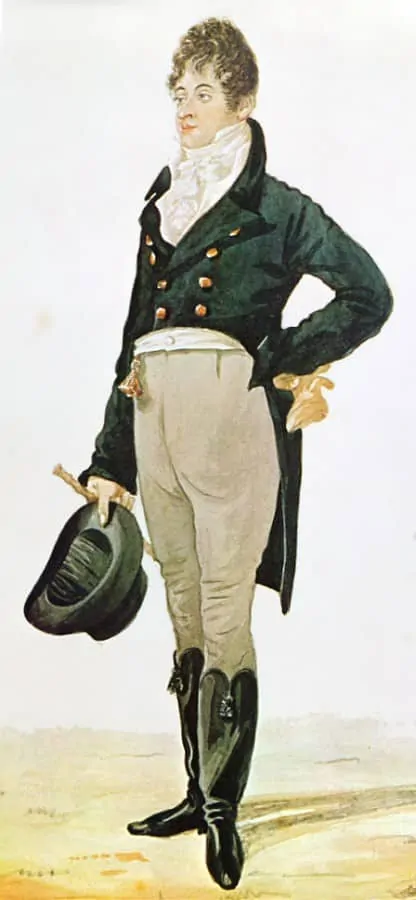
Beau Brummel in black boots
By the 1930’s, Edward the Prince of Wales had relaxed some menswear rules, leading to softer materials and bolder colors. He also was a supporter of brown slip-on spectator shoes (the most common type of two-toned shoes)and brown shoes in general. By the 1950’s, even English clothing guides such as Clothes and the Man by Sydney D. Barney advised: “Business and Daywear in town: a lounge jacket with matching waistcoat and trousers with footwear in black or brown, according to the suit.” In this context Barney declares, “Brown shoes with a dark blue suit are undesirable.”
On the other hand, evening dress was still rather formalized; Full Evening Dress with white tie and Dinner Dress both demanded black shoes.
So, you can see, by the 1950’s, the “no brown in town” rule was no longer valid, although black was still the color for evenings.

Three Neapolitans – Three different pairs of brown shoes
Today, dress codes are much more relaxed than they were in the fifties, and if you’re wearing a well-cut suit, you are likely to be more well-dressed than 90% of the people around you. Even if you wear brown country boots to a restaurant for dinner, chances are that your shoes are still more elegant than many other men — unless it is a respected establishment with a dress code. Many debonair Italians, for example, only wear black dress shoes for funerals, weddings, and formal evening events. Otherwise, they prefer wearing brown leather shoes in varying shades — such as dark brown or tan shoes — especially when paired with blue suits. In Britain, black still holds a certain association with business, at least in more conservative circles. Still, many Englishmen wear more than just black dress shoes for business, with conservative styles like brown oxford shoes becoming increasingly popular.
To be explicitly clear: Today, wearing brown shoes with your outfits is generally acceptable both in the evening and in town. With that said, certain outfits and situations still call for certain footwear; light tan shoes may not be the best option for the evening, and black shoes are imperative for black tie. Remember: just because you can wear brown shoes day and night, doesn’t necessarily mean you should.
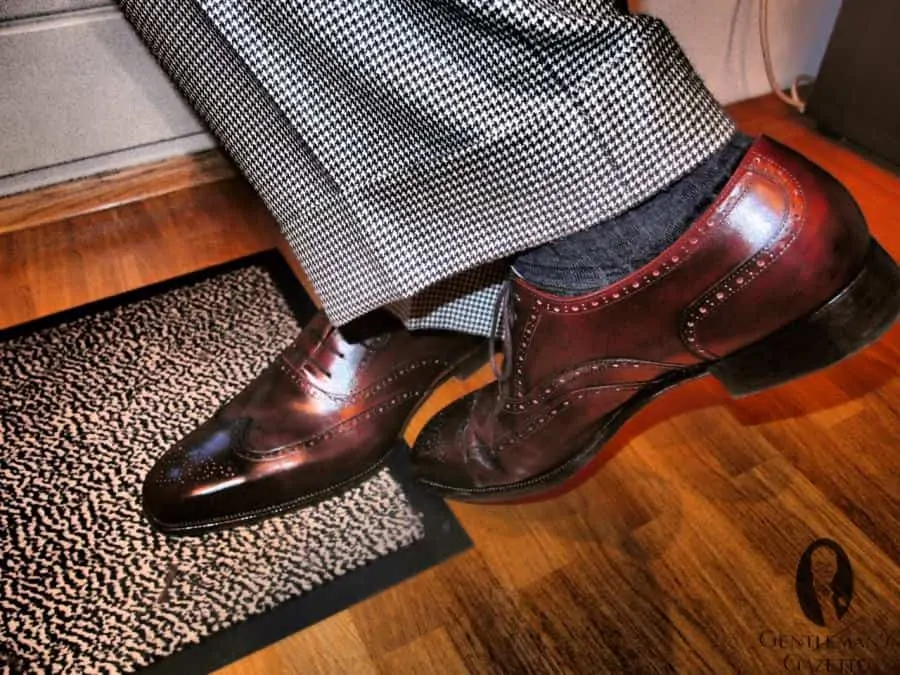
Brown Brogues (specifically, Wingtip Oxford Shoes) with houndstooth bespoke suit
When to Wear Brown Shoes
Brown shoes can be worn with almost anything, ranging from blue jeans to cavalry twill and corduroy to flannel, worsteds and tweed. Unlike black, brown leather comes in an endless variety of shades, allowing you to create a distinguished shoe collection that is unique. Here are a few guidelines that you can adopt and adapt as you please – just take a look in the mirror and use your sense of style.
1. Business Suits
For 3-piece or 2-piece business suits, in the following colors, in solid worsteds or flannels, pinstripes or faint windowpanes or Prince of Wales Checks:
- Black: Simply put, don’t wear a black suit with brown shoes. Black shoes, in a conservative style, work best.
- Charcoal Grey: We suggest black over any form of brown leather. Dark brown can work, but avoid tan shoes.
- Mid Grey: Black works, of course, but dark brown or cherry are also suitable colors. Once again, avoid tan.
- Dark Navy: Black works well with a navy suit, but cordovan, tan, and dark brown can also look magnificent and dashing. Of course, you will stand out visually with light tan shoes and a navy suit — something to bear in mind.
- Lighter Navy: Black will often look better than brown, but it ultimately depends on the cloth. With pinstripes, we suggest wearing black shoes and never brown.
- Dark Brown: Pair a dark brown suit with brown shoes, and skip black altogether.
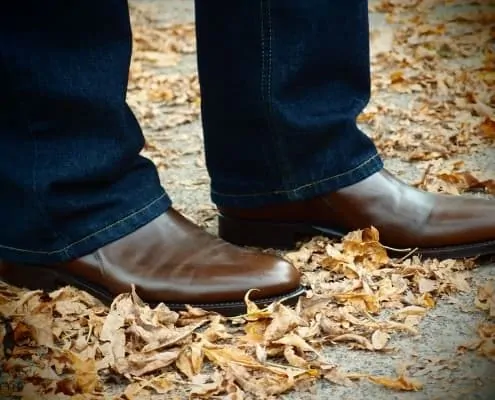
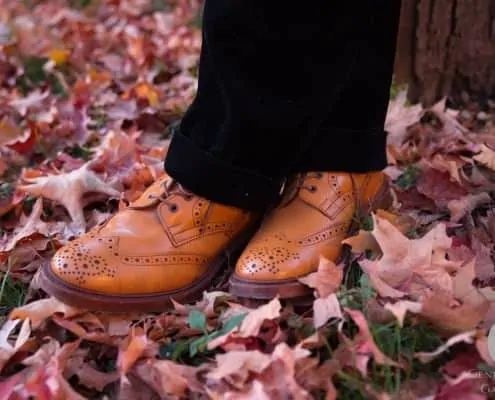
- Miscellaneous:
- Since a 3-piece suit is more formal than a 2-piece suit, the heightened formailty of black shoes means they will generally pair better with such outfits. Still, pay attention to the color, as above.
- If you wear a contrasting double-breasted waistcoat in dove grey or buff, go with black shoes as you will have created a similar ensemble to the formal stroller suit.
- If you want to play it safe, always choose a shade of brown dress shoes darker than your suit color.
- Of course, if you are confident enough, you can pair lighter shoe colors with dark suits, but be aware that you will gather more attention that way.
- Black remains the #1 color for business, so if you’re unsure, stick with black, and if you invest in your first pair of business shoes, go with a black captoe Oxford shoe.
- If you’re wearing a belt, try to match the color of the shoe to that of the belt. Since there are so many shades of brown leather shoes, your belt doesn’t have to be made of the exact same leather or the same color–just try to match it as closely as possible. If you wear suspenders, you won’t have to worry about this at all!
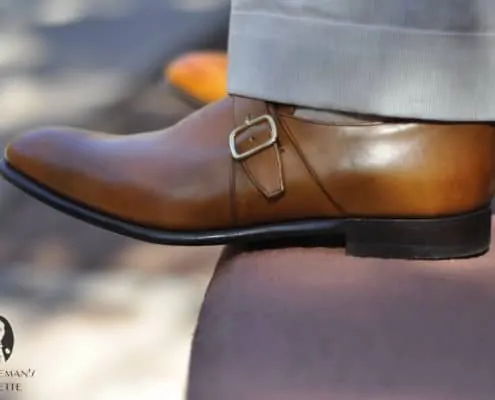
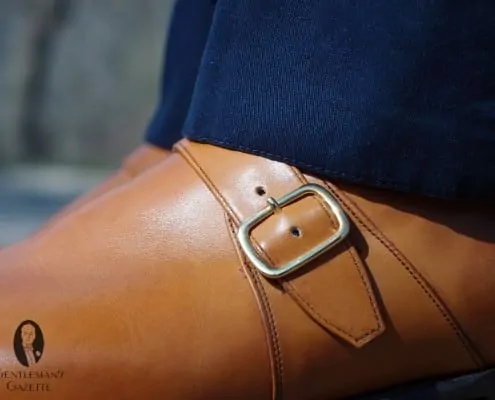
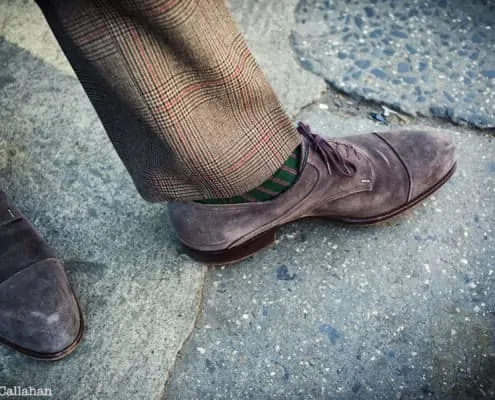
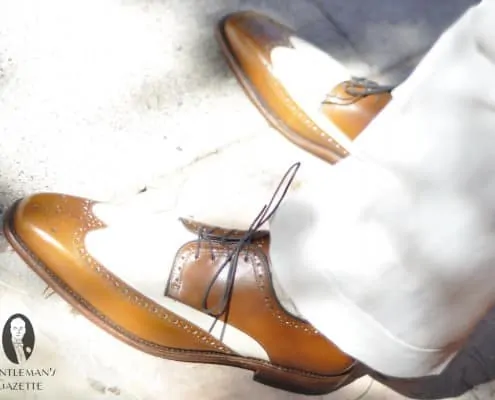
2. Casual Suits
Bolder patterns, material blends or brushed cotton, corduroy, etc.:
- Green: Brown every time, for all shades. Avoid black.
- Khaki: Dark browns work well. Avoid black.
- Tan: Cordovan, cherry and medium brown are great. Avoid black.
- White/Off White: Two-toned shoes, such as brown-and-white spectators, are a dapper choice, but dark brown, mid-brown or reddish brown work as well.
- Brown: As before, pair brown suits with brown shoes and skip black altogether.
3. Sport Coat / Odd Jacket – Trouser Combination
Fresco, Tweed, Thornproof, Cheviot, Donegal, Flannel, Worsted, Corduroy, Velvet, Cotton, Linen, Gabardine:
- Black: With black corduroy, tan leather boots (such as chukka boots or desert boots) are a good choice. Black dress pants worn with a sport coat will look best with black shoes, though more casual shoes like black loafers could be a good compromise in terms of formality.
- Charcoal Grey: We suggest black over any form of brown. Dark brown can work, but avoid tan.
- Mid Grey: Black works, but dark brown and cherry are also good colors. Avoid tan shoes.
- Blue: All kinds of brown men’s dress shoes can be worn with blue colors – cordovan, tan and dark brown can look especially smart. As before, you will garner more attention with a light tan shoe.
- Denim: Basically, all kinds of brown leather shoes work well, even with black jeans (similar to the corduroy example above). Tan and cordovan oxblood will serve you well here. Leather boots are a natural pair for jeans, though anything with a higher ankle would naturally interfere with skinny jeans (not that we necessarily advocate for such a style)!
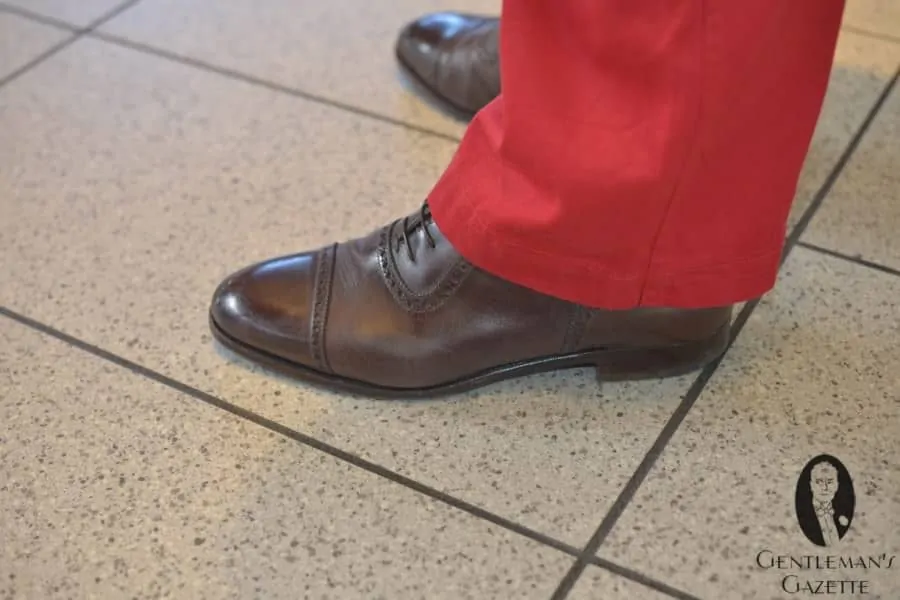
Chocolate brown half-brogue oxford by Antonio Pio Mele
- Red: All shades of brown work well, though reddish brown can look a bit too deliberate. Dark brown and tan are good choices
- Green: As before, try wearing brown every time, for all shades. Avoid black.
- Khaki: Dark browns work well. Avoid black.
- Tan: Cordovan, cherry and mid brown are great. Avoid black.
- White / Off White: Go for two-toned footwear, dark brown, mid-brown, or reddish brown.
- Brown: Brown only.
- Dark Brown: In a more smart-casual outfit such as this, tan works well when paired with dark brown.
- Miscellaneous: Brown is the best shoe and boot color for sport coats and contrasting trousers. Sometimes you may also see boots or shoes with fabric inserts, which can be quite stylish.
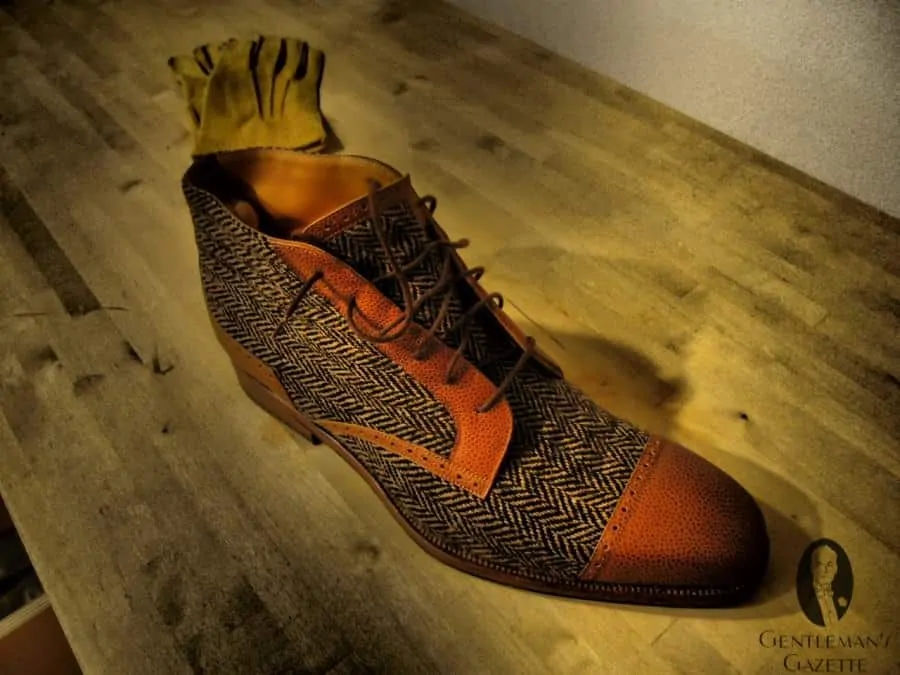
When not to wear brown shoes
If you wear formal morning dress (morning coat or stroller) or formal evening dress (white tie or black tie) you should not wear brown shoes – go with black. The exception for this exception could be a tuxedo in brown, as worn by Noël Coward, Nick Foulkes, or Lapo Elkann. In that case, a pair of matching velvet slippers could be an option, but that’s only for the very advanced clothes horse.
Don’t wear brown shoes with black suits.
Some traditionalists would argue that you should not wear brown shoes to the opera. However, if you look at the general dress code at operas today, you will likely be more well-dressed in a conservative pair of brown shoes than the other attendees.
How to Combine Brown Shoes with Socks: Vintage Fashion Illustrations
Brown half brogue shoe with shadow stripe socks in blue & red with navy chalk stripe suit
In the vintage illustration above, a navy chalk stripe worsted suit is paired with chestnut brown calf leather brogues. This illustration is from the 1930s, proving that men wore dark suits with brown shoes even then. Moreover, they were experimenting with creative weaves, such as these beautiful shadow stripe socks in blue and red (which can be worn with all kinds of navy suits). Alternatively, blue socks with clocks or blue stripes would be a more subtle alternative.
Shadow Stripe Ribbed Socks Dark Navy Blue & Royal Blue with Burgundy Derby Dress Shoe
Brown Oxford with patterned socks and pinpoint trousers
The above illustration shows the benefit of understanding color temperature–that is, pairing shoes, socks, and trousers with a warm tone. Below, chinos paired with burgundy striped socks and mid-brown suede derby shoes operates on the same principle. Further, suede shoes in general will always give a more casual appearance, and are therefore a dapper alternative to more common “casual” shoe styles today, such as sneakers.
Conclusion
Brown shoes are not a substitute for black shoes, and every man should own at least one pair of black plain Oxfords. If you work in a white-collar environment, you can invest in a few pairs of black leather shoes, but otherwise go with brown because it is more versatile, it develops a fantastic patina over time, and it is the better color for casual outfits. If you don’t work in an office environment and rarely attend formal evening events, a single pair of black shoes may be enough for you, but you can never have enough brown shoes! If you like formal evening wear, invest in a pair of black patent leather Oxfords (in Austria Derby’s) or opera pumps – it is historically the correct choice for evening wear, even though some prefer polished calf skin for evening shoes.
In the broad strokes, brown footwear–everything from loafers to lace-up boots, wing-tips to cowboy boots–sports an amazing versatility, and wearing brown shoes or boots with items as varied as button-down shirts and leather jackets will serve you well. All told, there’s a lot that brown can do for you.

